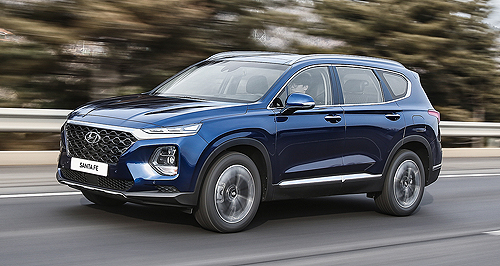Future models - Hyundai - Santa FeGeneva show: Hyundai details new-generation Santa FeJingle bells: The Santa Fe's steering and suspension will be tuned for Australian conditions prior to its arrival, offering improved responsiveness and vehicle stability, and a smoother ride. Hyundai goes large on safety and design for latest Santa Fe seven-seater22 Feb 2018 HYUNDAI has detailed the fourth-generation Santa Fe ahead of its Australian launch in the middle of this year with the seven-seat large SUV picking up a fresh design inside and out, improved ride and handling, and more active safety and convenience technologies. While the Santa Fe's new look broke cover earlier than expected two weeks ago, the Korean car-maker has confirmed its larger dimensions, with it now measuring in 4770mm long (+70mm), 1890mm wide (+10mm) and 1680mm tall (-10mm) with a 2765mm wheelbase (+65mm). As such, second-row legroom has increased by 38mm, while the bench itself sits 18mm higher. Meanwhile, third-row headroom has grown by 22mm. Cargo capacity is up 109 litres, to 625L, when the third row is stowed. Rear visibility has also improved thanks to a 41 per cent larger rear window. The 2.2-litre CRDi turbocharged four-cylinder diesel engine carries over, but its power and torque outputs have taken a small hit – down by 3kW and 4Nm, to 144kW and 436Nm. However, the former six-speed automatic transmission has been replaced by an eight-speed unit that once again employs a torque convertor. There has been no update regarding the future of the current 2.4-litre four-pot and 3.3-litre V6 petrol engines, but a plug-in hybrid option is rumoured to be on the horizon. The Santa Fe's all-wheel-drive set-up has added a new variable torque distribution system, dubbed HTRAC, which ''enables agile handling and better torque application depending on the wheel grip and the speed of vehicle'', according to Hyundai. Specifically, HTRAC works in tandem with the driving modes, with Sport and Comfort providing splits up to 50:50 and 65:35 respectively, while Eco mainly sends torque to the front wheels but can switch to all four corners if conditions are slippery. Yet again, the Santa Fe's steering and suspension will be tuned for Australian conditions prior to its arrival, with the marque also claiming improved responsiveness and vehicle stability, a smoother ride, and reduced noise, vibration and harshness (NVH) levels. To achieve this, the stiffer suspension has been placed vertically for longer travel length, external vertical shock absorbers have been added, the floor panel has been reinforced and the carpet features more materials than before. Technology-wise, the 8.0-inch touchscreen infotainment system offers Apple CarPlay and Android Auto support, while a fully featured head-up display is projected onto the windshield. Wireless smartphone charging has also been added. As previously reported, Hyundai has expanded its suite of SmartSense driver-assist technologies, namely with the addition of rear occupant alert, rear cross-traffic alert with automated braking and safety exit assist. Rear occupant alert monitors the rear seats via an ultrasonic sensor and alerts the driver if occupants – be it children, adults or pets – are still present when exiting the vehicle. This system also works if children accidentally lock themselves in. In such situations, the driver will initially be reminded with a message on the instrument cluster when the engine is switched off, followed by the horn activating and lights flashing if the vehicle is locked. Safety exit assist uses the radar to detect other vehicles approaching from behind and warns the driver when door without the child lock active is opened. For doors that do have the child lock activated, the vehicle will keep these doors locked in these scenarios, even if the driver attempts to unlock them. An acoustic warning is then issued to explain why. Other active safety features include forward collision warning, autonomous emergency braking with pedestrian detection, lane-keep assist, lane departure warning and blind-spot monitoring. Despite its unspecified weight loss, 57 per cent of the Santa Fe is now made of high-strength steel – 15 per cent more than its predecessor. According to Hyundai Motor Company executive vice-president Byung Kwon Rim, the company focused on customer safety and comfort for the new model. “The fourth-generation Santa Fe continues the model’s global success story. The first Santa Fe is the foundation of Hyundai Motor’s SUV heritage,” he said. “Hyundai truly cares about the customer’s well-being. We offer innovative and unique active safety features and class-leading roominess for extra comfort.” Local pricing and specifications will be released closer to the new Santa Fe's launch later this year. Santa Fe sales were slightly up last year, with 7974 examples sold to the end of 2017, representing a 1.8 per cent improvement over the 7834 deliveries made in 2016. The Hyundai model placed seventh in last year's sub-$70,000 large-SUV segment, tracking behind the Toyota Prado (15,982 units), Toyota Kluger (12,509), Subaru Outback (11,340), Holden Captiva (9588), Mazda CX-9 (9012) and Isuzu MU-X (8087).  Read more7th of February 2018  Geneva show: Bigger Hyundai Santa Fe revealedHyundai claims new Santa Fe large SUV will be roomiest in its class25th of January 2018  Geneva show: Safer Hyundai Santa Fe to lob mid-yearHyundai teases fourth-gen Santa Fe ahead of Geneva show debut, mid-year launch2nd of August 2017  Hyundai ups safety game for Santa FeActive safety and tech upgrades part of Hyundai Santa Fe model year update22nd of March 2017  Hyundai adds V6 power to Santa Fe rangeNew Hyundai Santa Fe Active X packs 3.3-litre V6, 19-inch alloys2nd of September 2016  Driven: Hyundai introduces ‘30’ Special Edition pairLimited-edition Hyundai Santa Fe could herald permanent V6-powered 2WD versionSanta Fe pricing
Motor industry news |
Click to shareHyundai modelsResearch Hyundai Santa Fe pricing
Motor industry news |





























Facebook Twitter Instagram